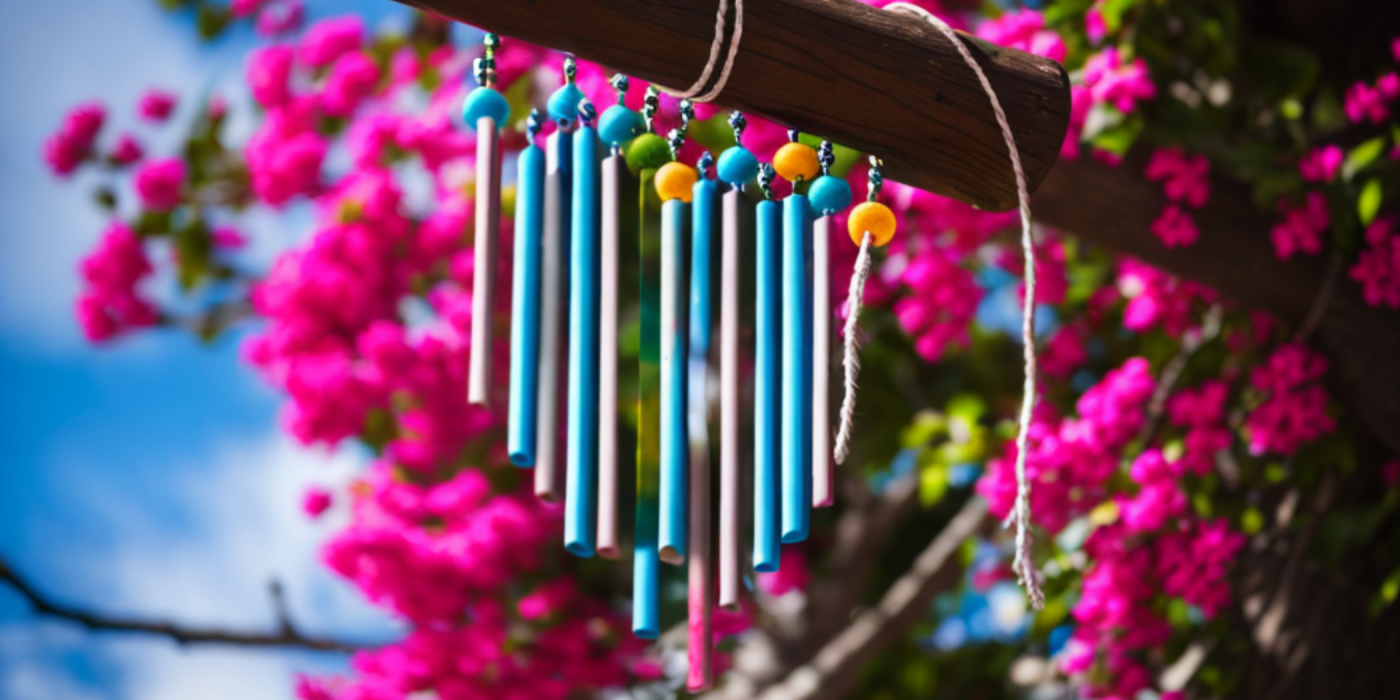Wind Chimes for Garden: A Comprehensive Guide to Beautify Your Outdoor Space

Wind chimes, a type of percussion instrument, have a rich and fascinating history. These delightful outdoor ornaments originated thousands of years ago in ancient civilizations. Archaeological finds reveal that the earliest wind chimes were used in Southeast Asia as far back as 3000 B.C. and they quickly spread to China, where they were used both in religious ceremonies and as a status symbol.
Over time, different cultures adopted wind chimes, imbuing them with their unique characteristics. Today, they're known and loved worldwide for their gentle melodies, decorative purposes, and the sense of peace they bring to outdoor spaces.
The Magic of Wind Chimes in the Garden
Why introduce wind chimes to your garden? The simple answer is they possess a unique charm. The dulcet tones produced as the wind dances through these chimes can turn a common garden into a soothing sanctuary.
But their magic extends beyond aesthetics and sound. In Feng Shui, wind chimes are used to enhance the flow of chi, or life force, drawing in positivity and fortune. Some believe that wind chimes can also deter evil spirits or bad luck.
From a more scientific perspective, the soft, rhythmic sounds of wind chimes can promote relaxation and reduce stress, contributing to overall wellbeing. They can even attract wildlife to your garden, as certain birds and animals are drawn to their enchanting melodies.
So, whether you're seeking an aesthetic enhancement, a calming atmosphere, a symbol of good fortune, or a wildlife attractor, wind chimes could be the perfect addition to your garden. Their rich history, visual appeal, and soothing sounds make them a timeless outdoor ornament, imbuing your garden with a unique and captivating character.
The Harmony of Wind Chimes
Understanding the Science of Wind Chimes
Wind chimes transform the invisible flow of wind into an audible experience, creating a symphony of sounds that have a calming and soothing effect on our minds. The principle behind this is simple physics. Each chime is a resonator. When struck by the clapper, the chime vibrates at its resonant frequency. The length, thickness, and material of the chime determine this frequency, thus producing distinctive sounds.
Metal wind chimes often generate harmonious or consonant intervals of sound due to their precision tuning, while bamboo or wooden chimes tend to produce more percussive, rhythmic sounds.
Resonance and Material
Material matters when it comes to the tonality of wind chimes. Metal chimes, for instance, create a long-lasting, bell-like resonance. In contrast, wooden or bamboo chimes have a shorter resonance, yielding a sharper, often more percussive, sound.
Glass or ceramic chimes can provide a blend of these soundscapes, creating both sharp and sustained tones, making them a versatile choice.
The Psychological Benefits
The sounds produced by wind chimes have long been associated with tranquillity and peace. Research has shown that certain frequencies and patterns of sound can stimulate the brain to produce chemicals like serotonin and dopamine, which play a key role in mood regulation.
The gentle, rhythmic pattern of wind chimes also helps create a sense of calm and focus. This aligns with practices like meditation and mindfulness, helping reduce stress and promote mental well-being. Therefore, having wind chimes in your garden not only adds an aesthetic element but also contributes to creating a relaxing and peaceful environment.
Different Types of Wind Chimes
In the world of wind chimes, the diversity is quite remarkable. The choice can be overwhelming, yet the perfect one can add a distinctive character to your garden. To simplify, we can classify them based on two primary factors - material and sound.
Material-Based Classification
Wind chimes are crafted from various materials, each offering a unique blend of durability, aesthetics, and resonance.
Metal Wind Chimes
Made typically from copper, aluminium, or brass, metal wind chimes are renowned for their durability and rich, resonant tones. Their long-lasting nature makes them suitable for all weather conditions.
Bamboo Wind Chimes
These provide a naturally rustic look and a soft, mellow sound that blends seamlessly with the outdoor environment. They may require more care due to their susceptibility to weathering.
Glass Wind Chimes
Glass chimes are visually stunning, often hand-blown or stained for an artistic appeal. Their delicate, tinkling sounds are soothing, though they require protection from strong winds.
Ceramic Wind Chimes
Crafted from fired clay, ceramic chimes offer both visual and auditory beauty. They are available in various designs, colours, and glazes, producing a deeper, resonant sound when struck.
Sound-Based Classification
The sound of wind chimes is influenced by their design. It can range from the delicate ring of bells to the profound resonance of tubes and rods.
Bell Wind Chimes
These chimes offer a melodious jingle that is soft and pleasing. Often used in small garden settings, they lend a fairytale-esque charm to your outdoors.
Tube and Rod Wind Chimes
Whether cylindrical or rod-shaped, these designs offer a rich and deep melody that can be heard over a larger area. They are excellent for larger gardens, providing a tranquil, ambient soundtrack to your outdoor living space.
By understanding these different types of wind chimes, you can make a more informed choice that resonates with your garden's character and your personal preferences.
Choosing the Right Wind Chimes for Your Garden
Factors to Consider
When choosing the perfect wind chimes for your garden, you need to consider a variety of factors that will ensure they enhance your outdoor space both acoustically and aesthetically.
Size of Your Garden
Your garden's size plays a crucial role in the type and number of wind chimes you can accommodate. Larger gardens can handle larger, louder chimes, while smaller spaces may be better suited to petite chimes with more delicate sounds.
Weather Conditions
The prevailing weather conditions in your area will influence your choice of material. Metal chimes are sturdy and can withstand a variety of conditions, while bamboo or wooden chimes may not fare as well in particularly wet climates.
Personal Sound Preference
Listen to different types of wind chimes before making a choice. The sound can vary dramatically depending on the material and design. Some people prefer the deep, resonant tones of large metal chimes, while others find the light, airy sound of bamboo or glass more pleasing.
Aesthetic Compatibility
Your wind chimes should harmonise with the overall design and feel of your garden. Consider the style, colour, and materials of the chimes to ensure they complement rather than clash with your outdoor décor.
Guidance on Selecting the Right Location
The location of your wind chimes can significantly impact their performance. They should be placed where the wind can reach them, but not in an area with constant, heavy wind that could lead to wear and tear. Optimal spots are often near windows or seating areas where you can enjoy their music and where they'll catch the sunlight to provide a visual treat as well.
Noteworthy Wind Chime Brands
Selecting the perfect wind chime for your garden can be a delightful experience, especially when you're familiar with the top brands in the market. Here, we'll introduce you to some of the renowned wind chime producers and their unique offerings, ensuring quality, aesthetics, and melodious tones.
Woodstock Chimes
Overview
Founded by musician Garry Kvistad in 1979, Woodstock Chimes is renowned for their musically tuned wind chimes. They use high-quality materials, including bamboo, aluminium, and steel, to create a wide range of chimes; each tuned to create harmonious melodies.
Quality, Materials, and Price Range
Woodstock Chimes offer superior durability and a pleasant sound. Prices range from £20 for a small, simple design up to £200 for larger, intricately tuned models.
QMT Windchimes
Overview
QMT Windchimes has been producing hand-tuned wind chimes in the USA for over 30 years. They use both metal and wood in their designs, delivering a perfect blend of modern and traditional aesthetics.
Quality, Materials, and Price Range
QMT Windchimes are known for their long-lasting chimes. Prices start from around £30 for basic models, rising to £150 for premium designs.
Corinthian Bells
Overview
Corinthian Bells is popular for their hand-tuned, high-density aluminium wind chimes. The brand is appreciated for their resonant and long-lasting tones, reminiscent of church bells.
Quality, Materials, and Price Range
Corinthian Bells wind chimes are incredibly durable and weather-resistant. They typically range in price from £50 for smaller models up to £300 for their larger chimes.
Choosing a brand is as personal as selecting the chime itself, and these are just a few of the quality brands available. Consider your garden's size, your aesthetic preferences, and the sound you'd like to achieve when making your selection.
DIY Wind Chimes for Your Garden
Creating your own wind chimes can be a rewarding way to add a personal touch to your garden. Not only will you be able to enjoy the soothing sounds, but you'll also have the satisfaction of knowing you crafted it with your own hands.
Materials Needed
The materials you need can vary depending on the type of wind chime you want to create. Here is a basic list for a simple wind chime:
- A sturdy stick or a metal ring for the top of the wind chime
- Wind chime pipes or tubes (can be metal or bamboo)
- Fishing line or strong thread
- Beads or other decorative elements
- A drill (for making holes)
Step-by-Step Guide
-
Preparation: Start by gathering all your materials. Decide on the number of pipes or tubes you want on your wind chime.
-
Drilling Holes: Carefully drill holes into the stick or metal ring and into the tops of your chime tubes.
-
Stringing It Together: Thread the fishing line through the holes in your stick or metal ring and then through your wind chime tubes. Add beads or other decorative elements as you desire.
-
Securing and Testing: Make sure to secure each line with strong knots. Test your wind chime to ensure it hangs correctly and produces a pleasing sound.
Personalising Your Wind Chime
Personalisation is the real charm of a DIY project. Here are some ideas:
- Paint the tubes or stick in your favourite colours.
- Add charms or trinkets that have special meaning to you.
- Use materials that resonate with you, such as shells for a beach theme or glass beads for a sparkly effect.
Remember, the aim is to create something that brings joy to your garden and resonates with your personal style. Enjoy the process, and happy crafting!
Wind Chime Maintenance and Care
Maintaining your wind chimes can enhance their longevity, sound quality, and overall appearance. Here, we delve into the best practices for taking care of your precious wind chimes, regardless of their material.
Metal and Glass Wind Chimes
Metal and glass wind chimes are typically the most resilient types. However, they aren't entirely immune to the elements.
Cleaning
For metal chimes, use a soft cloth and mild soap solution. Rinse thoroughly and pat dry. Glass chimes can be cleaned with a standard glass cleaner or vinegar solution. Always handle with care to avoid breakage.
Weather Protection
Though these materials are weather-resistant, they're not indestructible. During severe weather, it's advisable to bring them indoors. You might also consider applying a clear, weather-resistant lacquer on metal chimes to prevent rust.
Bamboo and Wood Wind Chimes
Bamboo and wood wind chimes require a bit more care, but their rich, deep tones make the effort worthwhile.
Cleaning
Dust them regularly using a dry, soft cloth. Avoid using water or cleaning solutions as these could damage the wood or bamboo.
Weather Protection
These chimes should be varnished annually to protect against damage from moisture and UV rays. Bring them indoors during the winter months or in periods of heavy rain to prevent warping and splitting.
The care you invest in your wind chimes will pay off as their enchanting melodies continue to fill your garden, creating a tranquil space for you to enjoy.
Conclusion
The Therapeutic and Aesthetic Charm of Wind Chimes
Wind chimes have been a part of various cultures for centuries, their music charming the listeners and creating an atmosphere of tranquillity. In our modern world, they continue to serve as sources of comfort and relaxation, their calming sounds contributing to mental wellbeing. Their therapeutic benefits are manifold, reducing stress, promoting relaxation, and aiding in meditation.
The gentle, melodious tones produced by the wind's interaction with chimes can create a harmonious backdrop in your garden, inviting a serene ambience that can truly make your garden a haven of peace. Beyond their auditory appeal, wind chimes also contribute aesthetically to your garden. With a wide variety of designs and materials available, these decorative items can greatly enhance the visual allure of your outdoor spaces, becoming a charming focal point amidst your flora.
Experimentation: The Key to a Harmonious Garden
Choosing the right wind chime and finding the perfect place for it in your garden is an art in itself. We encourage you to experiment with various types of wind chimes - be it bamboo, metal, glass, or ceramic - each carries its unique resonance that may appeal differently to your senses. Experimenting with different locations can also alter the frequency and volume of the sounds, creating a fascinating soundscape unique to your garden.
Remember, there's no set formula for this - your garden, your rules. It's about finding what resonates with your aesthetic and therapeutic preferences and creating a space that truly feels like an extension of your inner peace.
In conclusion, wind chimes are more than just decorative garden items. They carry therapeutic benefits, add aesthetic appeal to your outdoor spaces, and provide an opportunity for personal expression and creativity. So why wait? Let the wind play the symphony of your garden today.
Related to this article are the following:
I do hope you have enjoyed this article and hope that you will subscribe to my newsletter so you can get the latest information about all things naturally relaxing.
Stay in touch, join the Naturally Relaxing Newsletter
Newsletter Signup
Post Your Comments
or post as a guest
Be the first to comment.
Latest articles in Weather

Winter Getaways: Escape the Chill with These Enchanting Winter Destinations

Embrace Autumn's Coziness: Finding Comfort in the Magic of the Season

Understanding Seasons: Discover the Symbolic Meanings of the Four Seasons

Embracing Autumn: Your Ultimate Guide to Seasonal Preparation and Trends

Essential Tips for Staying Cool and Safe During a Scorching Heat Wave






